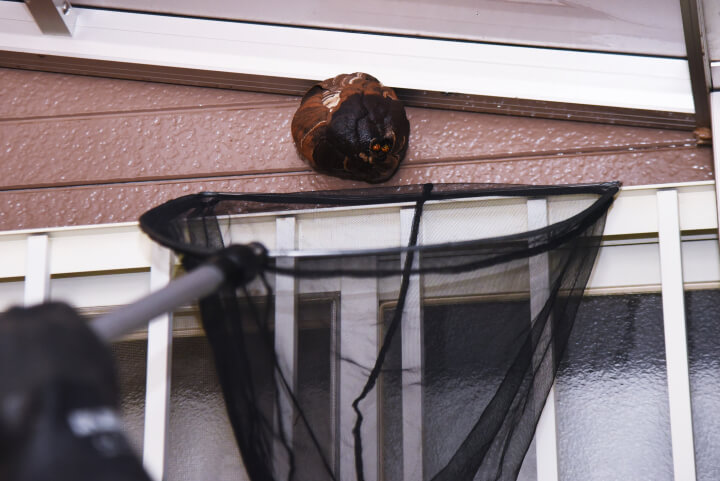


Hornets have the power to elicit fear among homeowners more than other pesky pests. They’re a problem when they’re seen lurking around, and they’re a major problem when they set up nests in your home. These invasive species are notorious for being aggressive and delivering painful stings to anyone disturbing them or intruding their nest.
How do you find a hornets nest? Where do hornets nest? Where do they hide and breed? Unlike other stinging insects, hornets like making their nests in secure locations, such as in a tree cavity or into a crevice of a building. But the best way to find what you're looking for is to know and identify first what you're looking for. And there are quite a lot.
Finding a hornet’s nest can be tricky, especially if you’re not familiar with its differences from other insects. They are part of the same order of insects called Hymenoptera. Wasps are classified into these two groups: solitary wasp (living alone) and social wasp (living in colonies).
Here's a quick guide on how to locate and classify menacing creatures.
| Pest | Appearance | Nest | Threat |
| Bumble bee | Within ¼ to 1 inch in size, have black and yellow markings, and an overall hazy look. | These bees build their bumble bee nests out of pollen clumps. | A bumble bee is considered a helpful insect because it pollinates flowers. Nevertheless, they can sting. If a nest is found in or near a structure, then control is needed. |
| Carpenter bee | Within 1/2 to 1 inch in size. They bear a resemblance tobumble bees, but the tip of their abdomen is mainly bare and glistening. | A carpenter bee doesn’t live in nests or colonies. Rather, they veered into the woods, where they produce galleries for rearing their young. Carpenter bees opt for decaying or dried wood to new or painted wood. | A carpenter bee is a dangerous property threat and can cause real harm over time if they aren’t killed. Male carpenter bees are territorial and fly in one's face aggressively, but they have no stinger and these behaviors are only for show. Female carpenter bees, on the other hand, possess a potent sting, which is seldom used. |
| Honey bee | Within 1/2-5/8 inch in size and orangish-brown or black. | Honeybees are social insects and exist as groups in hives, with mature colonies of 20,000 to 80,000 individuals. | A honeybee isn’t aggressive and doesn’t search for something to attack. It will only attack something that seems to threaten the honey bee colony. |
| Bald faced hornet | Largely black, with a predominantly white face. | A baldfaced hornet builds aerial nests out of paper cartons. The bald faced hornet nest is normally in exposed locations, usually on trees, utility poles, overhangs, or other structures. The nests can be considerably large, expanding to 14 inches in diameter and 24 inches in length. | Baldfaced hornets are considered beneficial insects by many since they control a lot of pest insect species. |
| European hornet | Big in size, between ¾ and more than 1 inch. They are brown with yellow abdominal lines and a pale face. | A European hornet creates paper carton nests. European hornet nest can be seen in areas like hollow trees and barns. | A European hornet is deemed a helpful insect because they control many pest species. However, if their nest is found near a structure, control is assured. |
| Mud Dauber Wasp | Long and slender, normally black, and may have pale markings or a metallic glow. | Mud daubers are actually solitary wasps and don’t reside in colonies. Instead, a female wasp constructs a mud nest. Many short mud tubes, ordinarily about 1 inch long, are built side by side. A mud wasp builds a ground nest in areas such as porch ceilings, under eaves, garages and sheds, barns, and protected building walls and attics. | They are deemed helpful insects because they control spiders. However, if their wasps nest is located near human activity, control is assured. |
| Ground hornet (cicada killer) | One of the biggest species of digger wasps in the U.S. They can be up to two inches in length and have black bodies that emphasize yellow markings comparable to those of yellow jackets | Ground hornets can nest almost everywhere. Once they start burrowing, they can create nesting sites up to 1 ½ feet beneath the ground's surface. | These wasps tend to be more solitary compared to other insects. Yet, when they form a ground wasp nest, they can elicit anger to your home or office and can be particularly risky if you or those around you are allergic to their sting. |
| Paper Wasp/Northern Paper Wasp | A type of wasp species is brownish with yellow or reddish markings | Paper wasps take their name from the paper-like substance of which they produce their nest. A paper wasps nest is ordinarily umbrella-like in shape and is never enclosed in an envelope. Nests are often seen hanging from twigs and branches of trees and shrubs, as well as porch roofs, door moldings, eaves, deck floor joints, rails, etc. | If a paper nest is touched, there’s a high possibility you’ll get stung, although paper wasps are typically not an intrusive type of wasp. Paper wasps are deemed helpful insects because they control many pest insect species. Nevertheless, if their nest is located near a house, control is assured. |
| Yellowjacket | Possesses a yellow and black pattern and is within 3/8 to 5/8 inches. | A yellow jacket resides in nests made of paper cartons. One yellow jacket nest will have a number of rounded paper combs. Depending on the species, the yellowjacket nests may be near the ground (plant roots, logs, timber, etc.). | Yellowjackets are reluctant to sting unless their nests are approached. Therefore, yellowjackets are deemed helpful insects because they control many pest insect species. Nevertheless, if their nest is found near a building, control is assured. |
| European paper wasp | Black wasps are yellow. They also have rings along the abdomen and spots in different areas on their clypeus (face) and stomach. | European paper wasp resides in warm and terrestrial habitats, such as forest, scrub, and meadow biomes. They live in urban, provincial, and agricultural areas. They manage to remain close to human civilization because they nest in human buildings. | European paper wasps are mobile and travel by flying and walking. They are social and exist in powerful hierarchies between the queen and the workers, including the working wasps. |
Nesting habits vary depending on the hornet species. Many of them gravitate toward similar areas. You’ll likely spot their nests in attics and wall voids. However, these stinging insects also make nests in roof eaves and tree hollows. When they find their new home, they create their nest from wood pulp. Meanwhile, one species, the ground hornets, likes to nest in open ranges with sandy soil. They need this for burrowing nests.
A hornet's nest is unique. Every wasps nest is thin, but the hornets' nest is formed like an inverted teardrop and has a small circular opening at the base where the hornets enter and exit. Queen hornets ordinarily go out when they forage for food. Usually, they strike honeybees and their hives, destroying them in mere hours and killing bees in what the scientist calls their "slaughter phase." They then invade the hive, feeding their offspring with the honey bees' eggs and larvae.
Now that you know How to find a hornets nest, removing a wasp nest by yourself is doable. However, getting rid of hornets can be risky if done wrongly. Most people try to get rid of hornets by using soapy water or fire aren’t so effective but can cause damage to your property or yourself.
The best way to get rid of an exposed nest is to use a pesticide to ensure all the wasps are gone before removing the nest, and that can take a while, based on the product you use. Unluckily, most products you can buy are not as efficient as a pest exterminator.
Performing hornet nest removal on your own can be done, but it can be risky and costly. So instead, we suggest having a pest control team get rid of the nest as they’re better equipped and help eliminate other pests on your property.
Learn More: Guide to Wasp and Hornet Traps
Getting rid of outside food sources will cause any flying insect to stay away. During late summer, pests like yellow jackets and hornets become more attracted to sugary foods to prepare for winter. To prevent them, including the Asian giant hornet, from dwelling in your home, make sure garbage cans are sealed and that food is not left unattended for an extended amount of time. Pet food that wasn’t eaten must be disposed of properly. Birdseed and hummingbird nectar should also be kept away. Keep flowers and fruit trees at a distance too.
Another long-term method of prevention is growing plants (citronella, eucalyptus, mint, and wormwood) that have scents that repel hornets. You may also use a fake hornets' nest to deter these pests. Since they’re solitary wasps and are territorial, they won’t build nests in areas where other hornets have nests. Hornet traps also work, but you have to be careful when disposing of them. When the trap catches hornets, seal it thoroughly in a bag or tape over the top and get rid of it in an outdoor trash container or place it in the freezer overnight. The cold will instantly kill the hornets.
No matter how capable you think you are in dealing with pests, avoid killing a hornet anywhere near its nest, as the distress pheromones it releases have a good chance of provoking an attack. You should also discard anything that touches the pheromones from the area instantly, like your clothes. Hornets can misrepresent the scent from certain perfumes and other volatile chemicals, which may wrongly begin an attack.
So when spending time outdoors, try to prevent wearing strong fragrances and sweet scents and instead opt for unscented hygienic products. If they smell something sweet, they might linger near you. These pests use their senses of smell to detect flowers, which tricks them into thinking that you might be one. Be sure to also wear boots to cover and protect your feet from rogue hornets.

Hornets are extremely dangerous. They’ll aggressively protect their nests and can sting multiple times, which in some cases cause fatal allergic reactions. Don't attempt to kill an individual or remove a nest on your own. Instead, call Permakill Exterminating. We can exterminate any pesky pest in your home. If you need continuous service, we’ll implement a comprehensive pest control strategy, removal, and long-term prevention. Request your free quote now.